The scope is an essential piece of equipment. Everyone from hunters to the military to your everyday shooters has enjoyed the ability to shoot farther and more accurately. There have been a number of advancements throughout history that have developed into some amazing pieces of technology. The shooting industry has gone from basic 1x powered scopes from the civil war to scopes that help shooters reach distances of up to and past 1000 yards, much with the help of the reticle.
One of the most essential pieces of a scope is the reticle. After magnification, the reticle helps a shooter make accurate shots and can also help judge distance and size of a target. Reticles come in many different shapes and sizes. They can be used for a number of different shooting styles or options. With so many different reticles on the market, it can become a bit confusing when trying to choose the right one for your shooting preference. This article hopes to break down some of the most common shooting reticles and help you pick the right one for any occasion.
The Red Dot Reticle
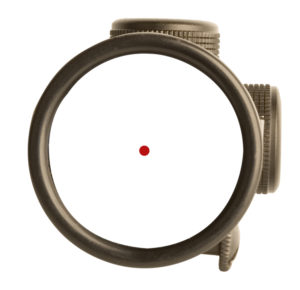 The red dot reticle is one of the more simple designs. When you look down your scope, you see a very simple red dot in the scope. The red dot sight is a newer reticle and was created in the 1970’s by a company called Aimpoint. Aimpoint is a Swedish company that provides the U.S. Army with their basic combat optic. Red Dot sights are often used by the military for their ability to quickly engage targets as well as their rugged reliability. It is difficult to knock a red dot sight off of its zero, so they do well in the military especially in an urban environment when engagement is generally closer.
The red dot reticle is one of the more simple designs. When you look down your scope, you see a very simple red dot in the scope. The red dot sight is a newer reticle and was created in the 1970’s by a company called Aimpoint. Aimpoint is a Swedish company that provides the U.S. Army with their basic combat optic. Red Dot sights are often used by the military for their ability to quickly engage targets as well as their rugged reliability. It is difficult to knock a red dot sight off of its zero, so they do well in the military especially in an urban environment when engagement is generally closer.
While the red dot may be simple, there are a number of advantages to using a red dot sight. They allow for quick target acquisition, you simply line the red dot up with the target and begin engaging the target. It is pretty straightforward, and red dot sights range in their price from the more expensive EOTech to cheaper brands. While the Red dot is a great option for close engagements, they are not great for targets past 150 yards. As the target gets smaller the further away it is, the red dot does not change in size. If a target is out past 150 yards, depending on your red dot, it may cover the target completely.
Crosshair Reticle
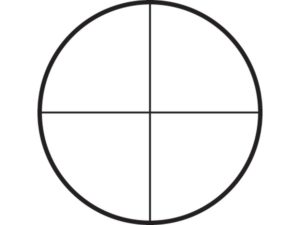 The Crosshair is the most basic reticle design. It is simple and merely has four lines that intersect in the middle. It is the rifle reticle that most comes to mind when you think about a rifle sight. There are few bells and whistles with this design, but it does allow for accurate shooting at greater distances, depending on the magnification. The design is simple to use, you basically align the crosshairs with your target and pull the trigger.
The Crosshair is the most basic reticle design. It is simple and merely has four lines that intersect in the middle. It is the rifle reticle that most comes to mind when you think about a rifle sight. There are few bells and whistles with this design, but it does allow for accurate shooting at greater distances, depending on the magnification. The design is simple to use, you basically align the crosshairs with your target and pull the trigger.
While this is a great choice for shooters that will be shooting targets at shorter distances. The farther out that you will be shooting the more likely you will want to invest in a sight that allows you to compensate for the distance as well as the natural bullet drop that occurs every time you shoot a rifle. However, this is a great sight for introducing a new shooter to the sport. Its basic design also offers most hunters that are not taking shot’s past 300 yards a great option for their sport.
German #1 and #4 Reticle
 The German rifle optics come in either #1 or the #4. These optics were developed by the German military during WWII. The #4 reticle is the more common, but you can still find a #1. The Number 1 is only three lines one from the bottom and two from the sides. It allows a shooter to engage a target quickly, but most shooters who use these reticles opt for the #4 due to its increased accuracy and better design.
The German rifle optics come in either #1 or the #4. These optics were developed by the German military during WWII. The #4 reticle is the more common, but you can still find a #1. The Number 1 is only three lines one from the bottom and two from the sides. It allows a shooter to engage a target quickly, but most shooters who use these reticles opt for the #4 due to its increased accuracy and better design.
The #4 optic has a small crosshair that has been added to the design. This allows for more accurate shots. The three bold lines allow the shooters eyes to look and engage a target quickly. This optic is limited to short to mid-range distance due to its lack of bullet drop compensation. However, this is an excellent sight for hunters to invest in, as they are better equipped for low light environments.
Duplex Reticle
 The duplex reticle is one of the most common reticles on the market today. It is similar to the crosshair reticle, but it does have some more advancements that increase the accuracy for shooters over greater distances. Most of the major hunting brands like Nikon and Leupold have a number of duplex reticles available.
The duplex reticle is one of the most common reticles on the market today. It is similar to the crosshair reticle, but it does have some more advancements that increase the accuracy for shooters over greater distances. Most of the major hunting brands like Nikon and Leupold have a number of duplex reticles available.
The duplex reticle is simply four lines that intersect in the middle. The reticle sports a thin center lines and the lines on the outside are heavier. The duplex reticle allows the eye to naturally come to the thin wire and allows for precision shooting.
The duplex reticle is a great choice for short to mid-range shooting and hunting. The duplex reticle is an ideal scope for low light condition and allows a shooter to engage a target accurately. While the duplex reticle does not offer many of the bells and whistles as other sights like the Mil-Dot, it is still possible to gauge distance with a duplex reticle. With some practice though it is possible to use your duplex reticle to gauge distance and take more accurate shots at longer range. This article about duplex reticles from American Rifleman helps to explain it in more detail.
Bullet Drop Compensation Reticle
 The Bullet Drop Compensation Reticle or BDC is also a very popular style of reticle available to all shooters. Like the crosshairs, German and the Duplex reticle, it has many of the same features except, the Bullet Drop Compensation has a number of horizontal lines that help shooters account for bullet drop. Everytime you fire a weapon, the bullet is immediately affected by gravity once it leaves the barrel. As the bullet travels a longer distance the bullet will eventually begin to drop, the Bullet Drop compensation helps a shooter adjust for gravities natural reaction.
The Bullet Drop Compensation Reticle or BDC is also a very popular style of reticle available to all shooters. Like the crosshairs, German and the Duplex reticle, it has many of the same features except, the Bullet Drop Compensation has a number of horizontal lines that help shooters account for bullet drop. Everytime you fire a weapon, the bullet is immediately affected by gravity once it leaves the barrel. As the bullet travels a longer distance the bullet will eventually begin to drop, the Bullet Drop compensation helps a shooter adjust for gravities natural reaction.
Each of the lines on the BDC determines a set distance; this allows the shooter to compensate for shots at longer distances, which will increase your accuracy. There are many positives about having a bullet drop compensation on your reticle, and investing in one will allow you to make longer shots. This will increase your effectiveness not only in target shooting but hunting as well. You will be better equipped to take longer shots and ensure a clean kill on the animal, which is the goal of every hunter.
Mil-Dot Reticle
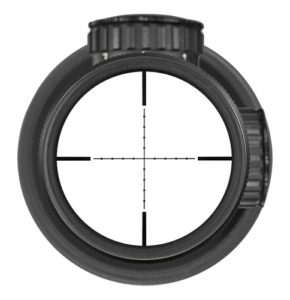 The Mil-Dot reticle is one of the more advanced optics that are available to shooters. This optic was created by Military snipers and allows a shooter to adjust for windage as well as elevation quickly. The design helps a shooter compensate for bullet drop. Most Mil-dot scopes offer some type of bullet drop compensation, that helps a shooter take shots out past 1000 yards. The name mil-dot refers to the reticle itself, as the reticle measures everything in Milliradians or “Mils.” Everything within the reticle has a meaning, as they are generally measured in 10 mils vertical and 10 mils horizontal. The "Mil-Dot Made Easy" article by Guns America has a detailed explanation of how to utilize a mil-dot site to its maximum potential.
The Mil-Dot reticle is one of the more advanced optics that are available to shooters. This optic was created by Military snipers and allows a shooter to adjust for windage as well as elevation quickly. The design helps a shooter compensate for bullet drop. Most Mil-dot scopes offer some type of bullet drop compensation, that helps a shooter take shots out past 1000 yards. The name mil-dot refers to the reticle itself, as the reticle measures everything in Milliradians or “Mils.” Everything within the reticle has a meaning, as they are generally measured in 10 mils vertical and 10 mils horizontal. The "Mil-Dot Made Easy" article by Guns America has a detailed explanation of how to utilize a mil-dot site to its maximum potential.
The mil-dot allows a shooter to adjust for a number of conditions quickly, and shooters can take more accurate cold barrel shots, as well as follow up shots. The Mil-dot sight is popular among the military, as well as long-distance competition shooters. Also, many hunters have begun using mil dot sights to allow them to shoot greater distances.
Illuminated or Non-Illuminated Reticle
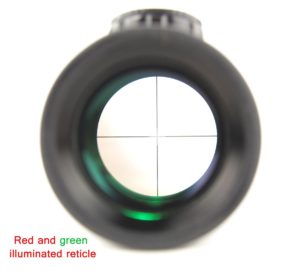 With even more advancements in technology, shooters are now able to purchase their sites with illuminated and non-illuminated reticles. The illuminated reticles provide a shooter with the light on the reticle. This is a very important advancement for hunters, as often times they will be forced to take shots at dusk or dawn when there is little light available. An illuminated reticle helps the shooter be able to see the sight better and make a more accurate shot. However, an illuminated sight may cost more, but they could have major payoffs in the end.
With even more advancements in technology, shooters are now able to purchase their sites with illuminated and non-illuminated reticles. The illuminated reticles provide a shooter with the light on the reticle. This is a very important advancement for hunters, as often times they will be forced to take shots at dusk or dawn when there is little light available. An illuminated reticle helps the shooter be able to see the sight better and make a more accurate shot. However, an illuminated sight may cost more, but they could have major payoffs in the end.
Conclusion
There are many different types of reticles to choose from on the market today. When a shooter or hunter is looking to purchase a scope, they must consider what they will be using the reticle for and what distances they are personally comfortable at taking shots at. You may not need to invest in an expensive scope if you are only shooting out to 300 yards. Choosing the right scope to match with your gun is an important decision, once you know what you are going to do with your rifle you can better choose the reticle that matches your need.
If you want to get into the world of long-distance shooting, or hunting at a greater range, then a Mil-dot scope may be the scope for you. Either way, just like anything in the world, it is a good idea to try a number of scopes and find the one that works best for you. I have personally found that the duplex scope with the BDC is a great all around scope that will allow for accurate shooting. Either way, I hope you get out there and continue to master your particular niche in the shooting industry.

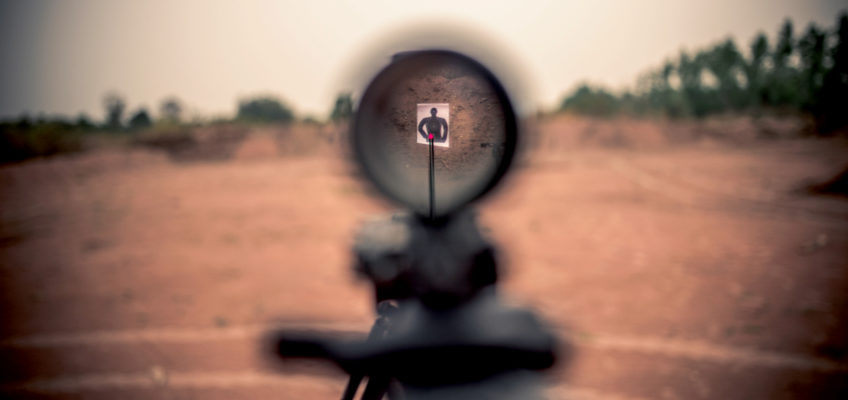
Leave a Reply